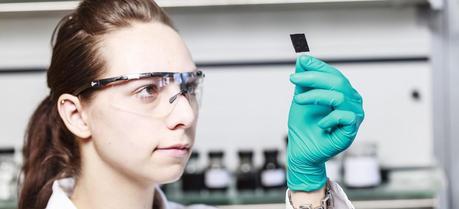 Innovative nano-material based supercapacitors are set to bring mass market appeal a good step closer to the lukewarm public interest in Germany. This movement is current-ly being motivated by the advancements in the state-of-the-art of this device. (Credit: Fraunhofer IPA)
Innovative nano-material based supercapacitors are set to bring mass market appeal a good step closer to the lukewarm public interest in Germany. This movement is current-ly being motivated by the advancements in the state-of-the-art of this device. (Credit: Fraunhofer IPA)ElectroGraph, a project supported by the EU, has succeeded in developing graphene-based electrodes for application in supercapacitors.
As the project approached its closing phase in June, the project coordinator at Fraunhofer Institute for Manufacturing Engineering and Automation IPA in Stuttgart, Carsten Glanz explained the concept and approach taken en route to its successful conclusion: “During the storage process, the electrical energy is stored as charged particles attached on the electrode material. So to store more energy efficiently, we designed light weight electrodes with larger, usable surfaces.”
SEE ALSO: Structural Supercapacitor Stores Energy, Bears Mechanical Load
In numerous tests, the researcher and his team investigated graphene, whose extremely high specific surface area of up to 2,600 m2/g and high electrical conductivity practically cries out for use as an electrode material. It consists of an ultrathin monolayer lattice made of carbon atoms. When used as an electrode material, it greatly increases the surface area with the same amount of material. From this aspect, graphene is showing its potential in replacing activated carbon—the material that has been used in commercial supercapacitors to date—which has a specific surface area between 1000 and 1800 m2/g.
“The space between the electrodes is filled with a liquid electrolyte,” revealed Glanz. “We use ionic liquids for this purpose. Graphene-based electrodes together with ionic liquid electrolytes present an ideal material combination where we can operate at higher voltages.” “By arranging the graphene layers in a manner that there is a gap between the individual layers, the researchers were able to establish a manufacturing method that efficiently uses the intrinsic surface area available. This prevents the individual graphene layers from restacking into graphite, which would reduce the storage surface and consequently the amount of energy storage capacity.
“Our electrodes have already surpassed commercially available one by 75 percent in terms of storage capacity,” emphasizes the engineer. “I imagine that the cars of the future will have a battery connected to many capacitors spread throughout the vehicle, which will take over energy supply during high-power demand phases during acceleration for example and ramming up of the air-conditioning system. These capacitors will ease the burden on the battery and cover voltage peaks when starting the car. As a result, the size of massive batteries can be reduced.”
In order to present the new technology, the ElectroGraph consortium developed a demonstrator consisting of supercapacitors installed in an automobile side-view mirror and charged by a solar cell in an energetically self-sufficient system (see video below).

